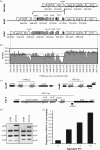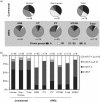The type 1 pili regulator gene fimX and pathogenicity island PAI-X as molecular markers of uropathogenic Escherichia coli
- PMID: 23744903
- PMCID: PMC3749053
- DOI: 10.1099/mic.0.066472-0
The type 1 pili regulator gene fimX and pathogenicity island PAI-X as molecular markers of uropathogenic Escherichia coli
Abstract
Uropathogenic Escherichia coli (UPEC) fall within a larger group of isolates producing extraintestinal disease. UPEC express type 1 pili as a critical virulence determinant mediating adherence to and invasion into urinary tract tissues. Type 1 pili expression is under regulation by a family of site-specific recombinases, including FimX, which is encoded from a genomic island called PAI-X for pathogenicity island of FimX. Using a new multiplex PCR, fimX and the additional PAI-X genes were found to be highly associated with UPEC (144/173 = 83.2 %), and more prevalent in UPEC of lower urinary tract origin (105/120 = 87.5 %) than upper urinary tract origin (39/53 = 74 %; P<0.05) or commensal isolates (28/78 = 36 %; P≤0.0001). The Fim-like recombinase gene fimX is the only family member that has a significant association with UPEC compared to commensal isolates. Our results indicate PAI-X genes, including the type 1 pili regulator gene fimX, are highly prevalent among UPEC isolates and have a strong positive correlation with genomic virulence factors, suggesting a potential role for PAI-X in the extraintestinal pathogenic E. coli lifestyle.
Figures


Similar articles
-
Comprehensive Identification of Fim-Mediated Inversions in Uropathogenic Escherichia coli with Structural Variation Detection Using Relative Entropy.mSphere. 2019 Apr 10;4(2):e00693-18. doi: 10.1128/mSphere.00693-18. mSphere. 2019. PMID: 30971446 Free PMC article.
-
LeuX tRNA-dependent and -independent mechanisms of Escherichia coli pathogenesis in acute cystitis.Mol Microbiol. 2008 Jan;67(1):116-28. doi: 10.1111/j.1365-2958.2007.06025.x. Epub 2007 Nov 25. Mol Microbiol. 2008. PMID: 18036139 Free PMC article.
-
Virulence genes and phylogenetic groups of uropathogenic Escherichia coli isolates from patients with urinary tract infection and uninfected control subjects: a case-control study.BMC Infect Dis. 2021 Apr 17;21(1):361. doi: 10.1186/s12879-021-06036-4. BMC Infect Dis. 2021. PMID: 33865334 Free PMC article.
-
Virulence factors of uropathogenic E. coli and their interaction with the host.Adv Microb Physiol. 2014;65:337-72. doi: 10.1016/bs.ampbs.2014.08.006. Epub 2014 Nov 4. Adv Microb Physiol. 2014. PMID: 25476769 Review.
-
Classical chaperone-usher (CU) adhesive fimbriome: uropathogenic Escherichia coli (UPEC) and urinary tract infections (UTIs).Folia Microbiol (Praha). 2020 Feb;65(1):45-65. doi: 10.1007/s12223-019-00719-x. Epub 2019 Jun 5. Folia Microbiol (Praha). 2020. PMID: 31165977 Review.
Cited by
-
Comprehensive Identification of Fim-Mediated Inversions in Uropathogenic Escherichia coli with Structural Variation Detection Using Relative Entropy.mSphere. 2019 Apr 10;4(2):e00693-18. doi: 10.1128/mSphere.00693-18. mSphere. 2019. PMID: 30971446 Free PMC article.
-
Pathogenicity Factors of Genomic Islands in Intestinal and Extraintestinal Escherichia coli.Front Microbiol. 2020 Sep 25;11:2065. doi: 10.3389/fmicb.2020.02065. eCollection 2020. Front Microbiol. 2020. PMID: 33101219 Free PMC article. Review.
-
Reciprocal Cooperation of Type A Procyanidin and Nitrofurantoin Against Multi-Drug Resistant (MDR) UPEC: A pH-Dependent Study.Front Cell Infect Microbiol. 2020 Aug 11;10:421. doi: 10.3389/fcimb.2020.00421. eCollection 2020. Front Cell Infect Microbiol. 2020. PMID: 32850505 Free PMC article.
-
Glucose alters the evolutionary response to gentamicin in uropathogenic Escherichia coli.Microbiology (Reading). 2025 Mar;171(3):001548. doi: 10.1099/mic.0.001548. Microbiology (Reading). 2025. PMID: 40153309 Free PMC article.
-
Comprehensive mutagenesis of the fimS promoter regulatory switch reveals novel regulation of type 1 pili in uropathogenic Escherichia coli.Proc Natl Acad Sci U S A. 2016 Apr 12;113(15):4182-7. doi: 10.1073/pnas.1522958113. Epub 2016 Mar 30. Proc Natl Acad Sci U S A. 2016. PMID: 27035967 Free PMC article.
References
Publication types
MeSH terms
Substances
Grants and funding
LinkOut - more resources
Full Text Sources
Other Literature Sources

